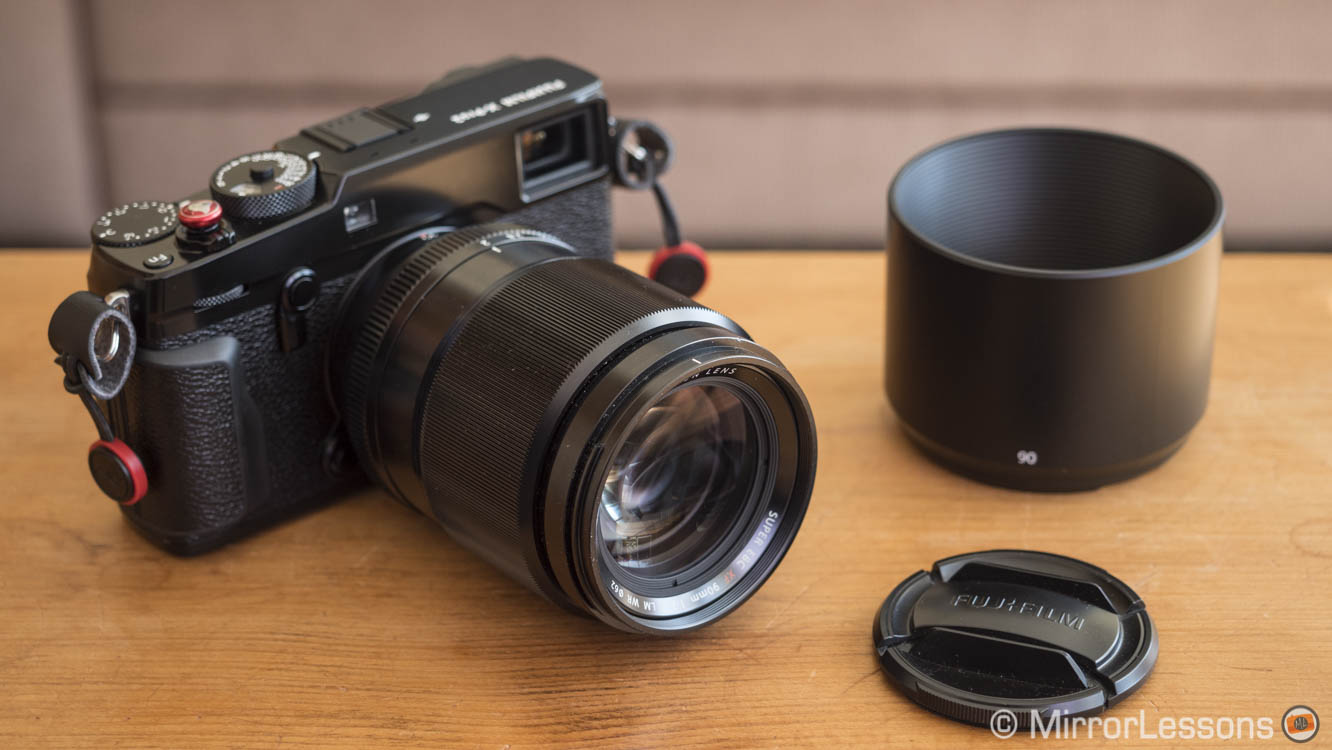The Fujinon XF 90mm f/2 was the third portrait lens released by Fujifilm in addition to the 56mm twins (non-APD and APD versions). It was announced last year in May and we had the chance to see a pre-production model during our trip to Toronto thanks to the kind people at Fujifilm Canada. Today we’ve finally had the chance to publish our full review!
Thinking in 35mm format terms, the lens has almost the same field of view as a 135mm lens which is a focal length often used for portraits. A focal length like this can be an addition or an alternative to the classic 85mm or 100/105mm lens, and can be very useful for genres other than portraits as well!
Is the XF 90mm f/2 an optimal solution for portraits and other genres that require a medium telephoto lens? Let’s find out!



Fujinon XF 90mm f/2 Main Specs
- Focal length: 90mm
- Focal length (equiv. 35mm): 137mm
- Maximum aperture: 2
- Minimum aperture: 16
- Number of aperture blades: 7 rounded diaphragm blades
- Angle of view: 17.9°
- Closest focusing distance: 60cm
- Lens configuration: 11 elements / 8 groups
- Special elements: 3 ED elements
- Lens surface coating: N.d.
- Maximum image magnification: 0.2x (0.3x 35 mm camera equivalent)
- Optical Image Stabilizer: None
- Dimensions: ø75 x 105 mm
- Filter diamater: ø62mm
- Weight: 540g (excluding lens cap, lens rear cap, lens hood)
[toc heading_levels=”3″]
Design and ease of use
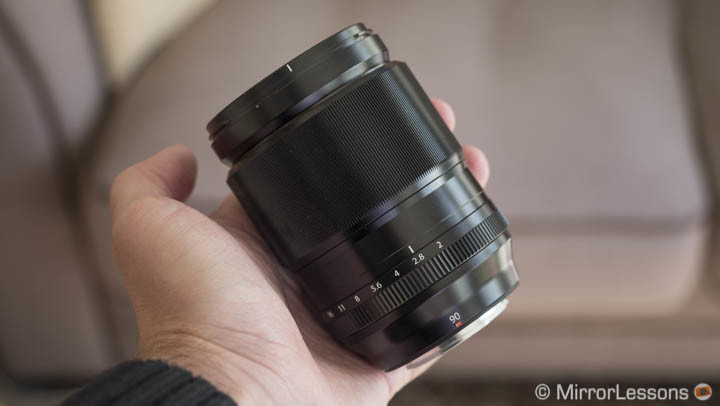
The Fujinon 90mm has an all-metal build and is completely weather sealed against moisture, dust and cold down to -10°C. The lens weighs half a kilogram but remains reasonably compact for an APS-C lens. I didn’t find it uncomfortable to carry around and you can fit it easily enough inside a medium sized bag. The length of the lens extends considerably with the provided plastic hood.
[twentytwenty]
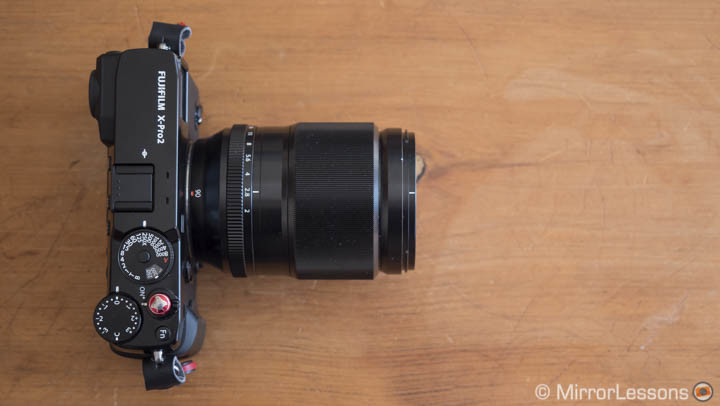
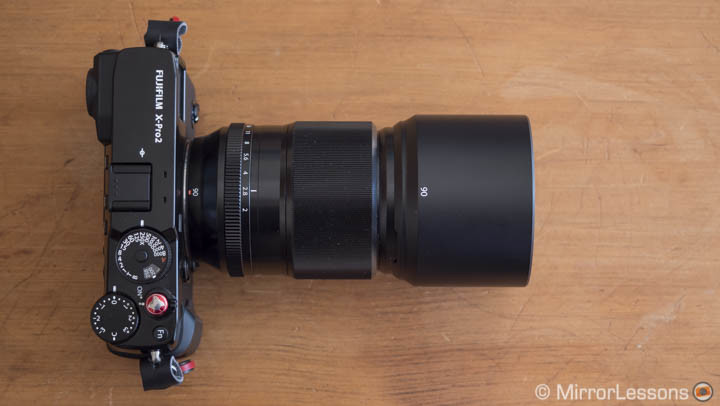
[/twentytwenty]
The focus ring is very large which enhances the user experience when manual focusing. We are talking about a focus-by-wire ring of course but as with most modern lenses, the ring is precise and comfortable to use. The aperture ring works in 1/3 steps and includes an A step for Shutter priority or Automatic modes. It doesn’t move too freely which is a good thing.
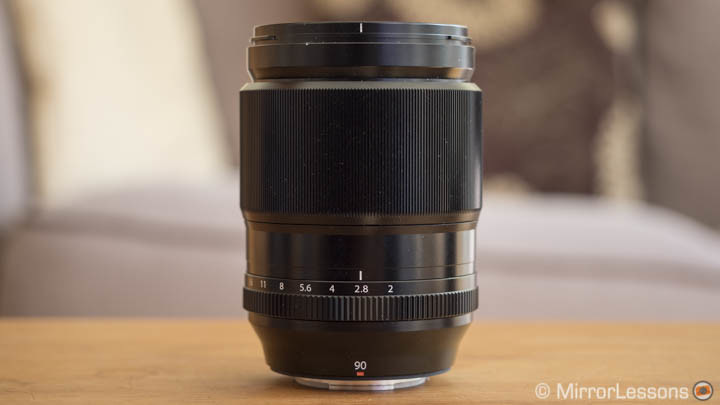
When holding the lens alone or mounted on the camera, you will feel something constantly moving inside the barrel if the camera is turned off. You might worry that something is broken inside but fear not: it is only because the AF system is composed of 4 motors linked to 4 magnets. When you power on the camera and consequently the lens as well, the magnets engage and the impression that something is moving inside the barrel goes away.
Through the lens: optical quality for portraits
Fujinon lenses rarely disappoint when it comes to sharpness and the 90mm is no exception. The performance is excellent at f/2 and becomes perfect from f/2.8. Diffraction is well contained at f/11 and slightly present at f/16. The lens is perfectly usable at all apertures.

Click on the image to open the full res version

Click on the image to open the full res version

Click on the image to open the full res version

Click on the image to open the full res version
The bokeh is creamy with pleasant rounded out of focus circles and almost no swirly effect at f/2. There aren’t any “cat’s eye” shapes at the edges, nor are there any invasive onion rings.

Click on the image to open the full res version.
From f/2.8 the blurred circles start to become less rounded and from f/4 they assume a hexagonal shape. For portraits, you want to stick between f/2 and f/2.8 for an optimal bokeh rendering. If you are in a studio environment or in another situation where the bokeh is not your main concern, then the performance at f/4 or even f/5.6 is excellent too.

Click on the image to open the full res version.
The lens works really well for knee or full-body shots as well. The long focal length and the fast aperture give you a nice look and enough shallow depth of field. The separation of the subject from the background is excellent.

Click on the image to open the full res version.
The lens can focus as close as 60cm which gives you 0.3x magnification (35mm format equivalence). It’s not a macro lens by any means but it can work well for close-up portraits or natural elements. Sharpness remains excellent.

Click on the image to open the full res version

Click on the image to open the full res version

Click on the image to open the full res version

Click on the image to open the full res version.
You can encounter some chromatic aberration at f/2 especially in very contrasty situations but it is gone at f/2.8. Flare resistance is good but direct sunlight can produce some veiling flare.

Click on the image to open the full res version

Versatility and autofocus performance
One characteristic I always observe with interest is sharpness at long focus distances. I like taking landscape pictures with telephoto lenses and the 90mm has an interesting field of view for this genre. I was happy to see that sharpness remains excellent from f/4 to f/8 both at the centre and at the corners. This is the first aspect that makes this lens versatile.

Click on the image to open the full res version

11 shots merged with Lightroom
The autofocus motor is the second reason for this versatility. Fujifilm decided to include a more advanced AF motor (Quad Linear) than the XF 50-140mm f/2.8 (Triple Linear). The result is one of the fastest AF lenses by Fujifilm I’ve ever tried. It works well in Single AF and exceptionally well in Continuous-AF on both the X-T1 and X-Pro2. The AF motor is silent and the performance in C-AF remains constant for video on the X-Pro2 as well.
This means that the 90mm can be a good solution for action and certain sports like marathons, bike or mountain bike races or any sports where the photographer can be close enough to the action. Granted, a zoom lens will always be more versatile but if you shoot sports occasionally, the 90mm could prove enough to do the job.


It is also an excellent lens to use for outdoor events when you have more space to move around and capture portraits from a distance (either because you don’t want to be too close or because you can’t get closer). I found it to be enough to capture other scenes too, such as musicians playing on the street. I had the chance to use it at the Colwyn Bay 1940s Festival and it was the ideal focal length for the situation.





Fuji XF 90mm f/2 vs XF 56mm F/1.2
I am sure many are wondering which portrait lens is better: the 56mm or the 90mm. Price wise, they are the same so that’s an argument we can check off the list. From an optical quality point of view, I find them very similar concerning the quality of the bokeh wide open and sharpness (with perhaps a slight advantage going to the 90mm). The difference in shallow depth of field is not too dissimilar in the end because what you gain with one thanks to the fast aperture can be re-gained with the other thanks to the longer focal length and close focusing capabilities.
The main difference is the most obvious: the angle of view.
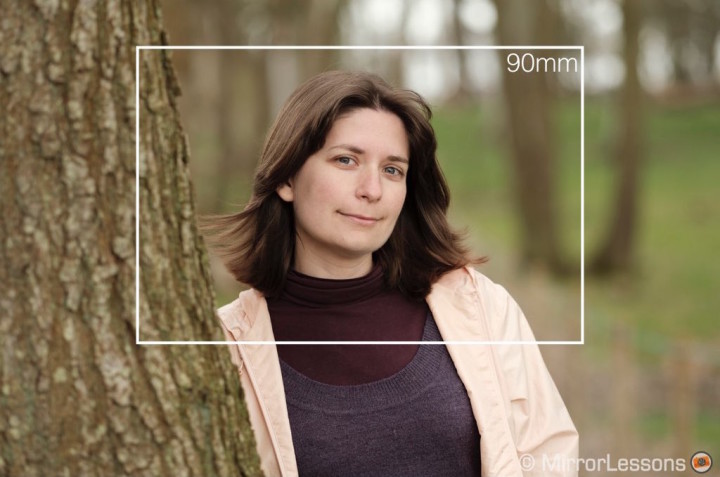
The 56mm is definitely more handy indoors and in tight spaces so if that is where you shoot most of the time, it is the wiser choice. Wedding photographers could find the fast aperture of 1.2 more useful for low light and indoor environments.
The 90mm’s narrower field of view makes it more interesting for outdoor shooting, indoor shooting if you are interested in close-ups, and if you want a medium telephoto lens that can serve other purposes thanks to the very fast AF motor (definitely faster than the 56mm).
Personally I would choose the 90mm, because I don’t shoot portraits every day. I could see it being the only telephoto option in my bag, allowing me to keep my kit compact. Portrait photographers could easily own both if they are shooting portraits every day in different locations and conditions.
Additional reads:
Conclusion
I liked the idea of the XF 90mm f/2 since its announcement last year. Having finally had the chance to use it just confirmed this. It’s a great portrait lens, and it focuses very fast for both stills and video, making it very usable for sports events like marathons or a mountain bike races. Its field of view is also useful for capturing portraits at open air events. The cherry on top is the weather sealing.
It can substitute any telephoto zoom lenses if you don’t need to go past 100mm (150mm in 35mm format terms) and are willing to move more to frame your shot, and its compact size means you will likely bring it everywhere you go. However, unless you shoot portraits every day for a living, I would hesitate to suggest this lens over the XF 56mm f/1.2.

All that’s missing is optical stabilisation. Now, it is not uncommon for this type of prime lens to lack optical stabilisation. Including it would have been a surprising addition that would have made this lens an absolute must-have. At the same time, I can imagine that the size and price would have increased as well. In the end, I managed to bring home some excellent images without O.S. so it is possible – you just need to be more aware of your shutter speed.
I find the price of nearly $800 to be reasonable. It is not cheap but given the various applications for which you can use the lens and the excellent optical quality, it is a good investment.
 What I like about the Fujinon 90mm f/2:
What I like about the Fujinon 90mm f/2:
- Completely weather sealed
- Sharpness is excellent from f/2 already
- Very fast AF performance (video mode included)
- A versatile lens that can work for various genres and not just portraits
 What I don’t like about the Fujinon 90mm f/2:
What I don’t like about the Fujinon 90mm f/2:
- Some C.A. at the fastest aperture
- Optical stabilisation would have been a welcome feature but it’s not a deal-breaker.
